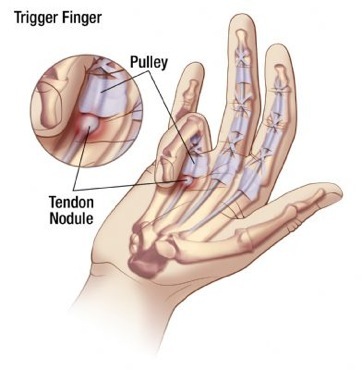
“Trigger finger,” or stenosing tenosynovitis, is very common. The tendons that flex your fingers have to glide underneath pulleys, or tunnels, in order to bend the fingers. Sometimes, the tendon or the pulley gets swollen or inflamed and the tendon cannot slide under the pulley.
The swollen tendon causes a painful area or even a nodule at the base of the finger on the palm side. The finger can “click” or “lock,” or even get stuck in a flexed position! More triggering causes more inflammation, so the condition can worsen.
Trigger finger is more common in people with diabetes, rheumatoid arthritis, and gout, but most cases are “idiopathic,” or without known cause!
Treatment is aimed at eliminating the “locking” and allowing painless full motion of the finger. Anti-inflammatories, splinting, activity modification, or other endeavors to decrease swelling can be helpful. The most common initial treatment, steroid injection around the area, can be quite effective.
If your trigger finger is not relieved by injection of steroid, your doctor might suggest surgery to open the pulley at the base of your finger where the tendon is catching. This surgery usually is performed under local anesthesia. After surgery, your doctor might ask you to begin active motion right away to keep the tendon gliding.